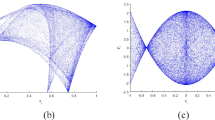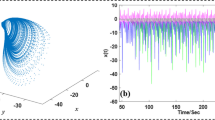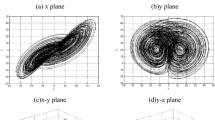Abstract
The existing chaotic image encryption algorithms have common defects: (i) ciphertext does not participate in the generation processes of chaotic pseudo-random sequences and key sequences; (ii) the entire encryption process does not have a closed-loop structure. In order to solve above problems, in this paper, an image segmentation encryption algorithm based on hyperchaotic system is proposed. We decompose the scrambled sequence into three sequences of different lengths: S1, S2 and S3. Then, the initial values of the chaotic system are updated by the sequences S2 and S3 and using the updated initial value iterates the chaotic system and generates the key sequence K3, and the sequence S1 is encrypted by the sequence K3 to obtain the cipher sequence C1, using the sequences C1 and S3 updates the initial value of the chaotic system, and using the updated initial value iterates the chaotic system and generates the key sequence K4, and using the sequence K4 encrypts the sequence S2 to obtain the cipher sequence C2. Thus, ciphertext participates in the generation processes of chaotic pseudo-random sequences and key sequences, and the entire encryption process has a closed-loop structure. The experimental results show that the encryption algorithm has high security and sensitivity.








Similar content being viewed by others
References
Alvarez G, Li S (2006) Some basic cryptographic requirements for chaos-based cryptosystems. Int J Bifurcat Chaos 16(08):2129–2151
Arroyo D, Diaz J, Rodriguez FB (2013) Cryptanalysis of a one round chaos-based substitution permutation network. Signal Processing 93(5):1358–1364
Chai XL, Gan ZH, Lu Y et al (2016) A novel color image encryption algorithm based on genetic recombination and the four-dimensional memristive hyperchaotic system[J]. Chinese Physics B 25(10):100503
Cheng G, Wang C, Xu C (2020) A novel hyper-chaotic image encryption scheme based on quantum genetic algorithm and compressive sensing[J]. Multimed Tools Appl 79(39):29243–29263
Deng Q, Wang C, Yang L (2020) Four-wing hidden attractors with one stable equilibrium point[J]. Int J Bifurcat Chaos 30(06):2050086
Ghebleh M, Kanso A, Noura H (2014) An image encryption scheme based on irregularly decimated chaotic maps. Signal Processing Image Communication 29(5):618–627
Kaur M, Kumar V (2018) Efficient image encryption method based on improved Lorenz chaotic system[J]. Electronics Letters 54(9):562–564
Kwok HS, Tang WKS (2007) A fast image encryption system based on chaotic maps with finite precision representation. Chaos, Solitons and Fractals 32(4):1518–1529
Li C, Lin D (2016) Lü, J H. Cryptanalyzing an Image-Scrambling Encryption Algorithm of Pixel Bits. IEEE Multimedia 24(3):64–71
Lin H, Wang C, Tan Y (2020) Hidden extreme multistability with hyperchaos and transient chaos in a Hopfield neural network affected by electromagnetic radiation[J]. Nonlinear Dynamics 99(3):2369–2386
Lin H, Wang C, Yao W et al (2020) Chaotic dynamics in a neural network with different types of external stimuli[J]. Commun Nonlinear Sci Numer Simul 105390
Liu M, Feng J, Tse CK (2010) A new hyperchaotic system and its circuit implementation. Int J Bifurcat Chaos 20(04):1201–1208
Liu L, Zhang Q, Wei X (2012) A RGB image encryption algorithm based on DNA encoding and chaos map[J]. Computers & Electrical Engineering 38(5):1240–1248
Liu H, Wang X, Kadir A (2013) Color image encryption using choquet fuzzy integral and hyper chaotic system. Optik - International Journal for Light and Electron Optics 124(18):3527–3533
Liu Y, Tang J, Xie T (2014) Cryptanalyzing a RGB image encryption algorithm based on DNA encoding and chaos map. Optics & Laser Technology 60:111–115
Patidar V, Pareek NK, Sud KK (2009) A new substitution–diffusion based image cipher using chaotic standard and logistic maps. Communications in Nonlinear Science and Numerical Simulation 14(7):3056–3075
Rhouma R, Solak E, Belghith S (2010) Cryptanalysis of a new substitution-diffusion based image cipher. Commun Nonlinear Sci Num Simul 15(7):1887–1892
Wang XY, Yang L, Liu R et al (2010) A chaotic image encryption algorithm based on perceptron model. Nonlinear Dynamics 62(3):615–621
Wang C, Xia H, Zhou L (2017) A memristive hyperchaotic multiscroll jerk system with controllable scroll numbers[J]. Int J Bifurcat Chaos 27(06):1750091
Wang SC, Wang CH, Xu C (2020) An image encryption algorithm based on a hidden attractor chaos system and the Knuth–Durstenfeld algorithm[J]. Optics and Lasers in Engineering 128:105995
Xu C, Sun J, Wang C (2020) An image encryption algorithm based on random walk and hyperchaotic systems[J]. Int J Bifurcat Chaos 30(04):2050060
Xu C, Sun J, Wang C (2020) A novel image encryption algorithm based on bit-plane matrix rotation and hyper chaotic systems. Multimed Tools Appl, 79(9–10):5573–5593.
Ye G (2010) Image scrambling encryption algorithm of pixel bit based on chaos map. Pattern Recognition Lett 31(5):347–354
Ye G, Huang X (2017) An efficient symmetric image encryption algorithm based on an intertwining logistic map[J]. Neurocomputing 251:45–53
Yin Q, Wang C (2018) A new chaotic image encryption scheme using breadth-first search and dynamic diffusion[J]. Int J Bifurcat Chaos 28(4):1850047
Zhen P, Zhao G, Min LQ, Jin X (2016) Chaos-based image encryption scheme combining DNA coding and entropy. Multimed Tools Appl 75(11):6303–6319
Zhou M, Wang C (2020) A novel image encryption scheme based on conservative hyperchaotic system and closed-loop diffusion between blocks[J]. Signal Processing 171:107484
Zhou Y, Cao W, Chen CLP (2014) Image encryption using binary bitplane[J]. Signal Processing 100:197–207
Zhu M, Wang C, Deng Q et al (2020) Locally active memristor with three coexisting pinched hysteresis loops and its emulator circuit[J]. Int J Bifurcat Chaos 30(13):2050184
Acknowledgments
This work is supported by the National Natural Science Foundation of China (No.61971185) and Natural Science Foundation of Hunan Province(2020JJ4218).
Author information
Authors and Affiliations
Corresponding author
Additional information
Publisher’s note
Springer Nature remains neutral with regard to jurisdictional claims in published maps and institutional affiliations.
Rights and permissions
About this article
Cite this article
Deng, J., Zhou, M., Wang, C. et al. Image segmentation encryption algorithm with chaotic sequence generation participated by cipher and multi-feedback loops. Multimed Tools Appl 80, 13821–13840 (2021). https://doi.org/10.1007/s11042-020-10429-z
Received:
Revised:
Accepted:
Published:
Issue Date:
DOI: https://doi.org/10.1007/s11042-020-10429-z




